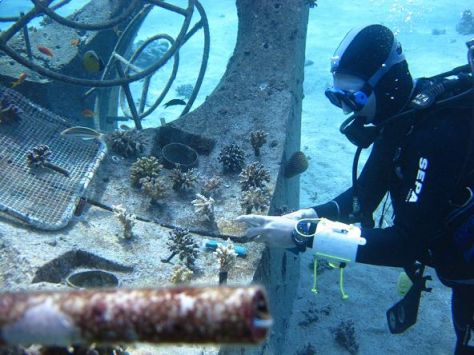225 soft and hard corals were planted in one day in the waters of the Red Sea with the aim of speeding up biological processes, "blooming the marine wilderness", and protecting natural coral reefs

In the midst of the activity in Gaza, during which frontal studies at Ben Gurion University are suspended, students from the Marine Biology and Biotechnology program of the Ben Gurion University campus in Eilat, in collaboration with students from the Seas and Lakes Research Institute, entered the waters of the Red Sea this weekend for another operation planting corals on the "Tamar Reef" .
"Tamar Reef", which was established by university researchers about a year and a half ago in cooperation with the Nature and Parks Authority, the Shonet Association and the Inter-University Institute in Eilat, is part of a bi-national research that focuses on the use of artificial substrates in combination with coral planting to speed up biological processes, "the flowering of the marine wilderness". and protection of natural coral reefs. This is based on the assumption that the more attractive the artificial reefs will be for divers and visitors, the lower the pressure exerted on the nearby natural reef will be.
According to the researcher in charge of the project on behalf of the university, Dr. Nadav Shesher, the artificial reef was built in close proximity to the Almog reserve and indeed attracted many divers. As a result, corals grown on it were damaged, especially during the holidays between Rosh Hashanah and Hanukkah. "Despite the damage to the corals, and perhaps due to it, it can be seen that there is a lot of use of the new reef among the nearby diving clubs and among the divers in the area. In general, it can be said that coral damaged by the artificial reef is coral shaded by the natural reef. This evidence proves the necessity and the partial success of the Tamar Reef in reducing damage to the Almog Beach Reserve," says Dr. Shasher.
The corals that were planted were grown in front of the Inter-University Institute for over two years using methods developed by the group of coral researcher Dr. Baruch Rinkevich from the Seas and Lakes Research Institute. The planting, which was conducted under the direction of Omar Polak, who studies the reef as part of his doctoral thesis, was very successful, and in one day 225 soft and hard corals were planted. Now the partners in the planting operation are waiting to see if the corals will take in and to monitor how they grow. Planting efforts at Tamar Reef will continue in the future as well.

3 תגובות
Note: Please make sure to darken the letters of the site a bit, which will allow the content to be read, printed and passed on to others more easily.
Thanks in advance,
Baruch Sefrai.
Sorry, one more word - I forgot because of excitement and joy:
Sea lilies. As someone who did his master's thesis on sea lilies, I am aware of how easily these are caught. The sea lilies are beautiful to look at, multiply quickly, cover a large area and even allow the artificial creation of a stigma of the same lily. I would suggest choosing the beautiful brown apatises and while sacrificing some details of them, apply them to the artificial reef. Instead of the application, new and new roses will bloom for them. If the real goal is to create an attraction for divers, the sea lilies will also do the job. And of course there is nothing easier than growing sea lilies (in fact, the hardest thing is to make them disappear).
Ami Bachar
Omer Polak, Hesher Kahr. This is already the second article I read in science about your exploits on the Eilat reef. Well done, keep it up and your place in the next world is guaranteed.
In my uneducated opinion, you should invest in soft corals in artificial reefs. They are just as beautiful and much less damaged. Divers will be attracted who do not understand almog what it is and what is the difference between 8 and 6 partitions. The soft corals are very attractive in their colors and movements (dendronaphetic and pulsating xenias, respectively) and I am not aware of a decline or damage to their population in relation to the population of hard corals.
And if it's hard corals, I'd recommend the massive ones. And I would recommend collecting the massive ones from the shallowest areas in the sea, right where you enter with your feet and step on them, even before the body sinks. There are many Fabias/Pabites and occasionally Platygars as well. These are indeed damaged, but the damage to them seems to be less severe than a direct damage to stylophores or acrophores (branching corals). When a winged coral is hit, it breaks. When a massive coral is damaged, the local tissue can die and it can heal. Either way, even if the coral dies, its skeleton is still there - which continues to fill the artificial coral-like reef on the one hand and allows for future settlement on the other.
Good job, go up and succeed.
Greetings friends,
Ami Bachar